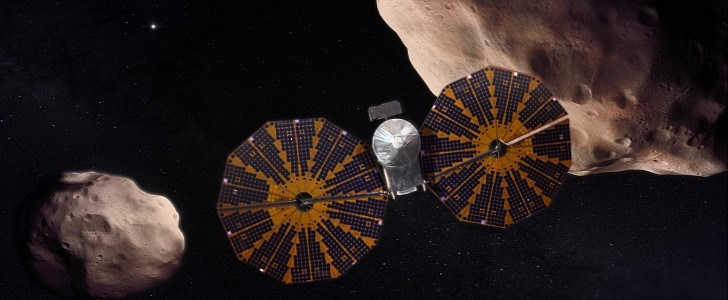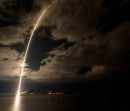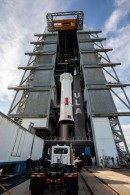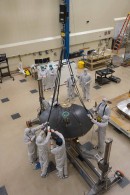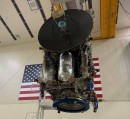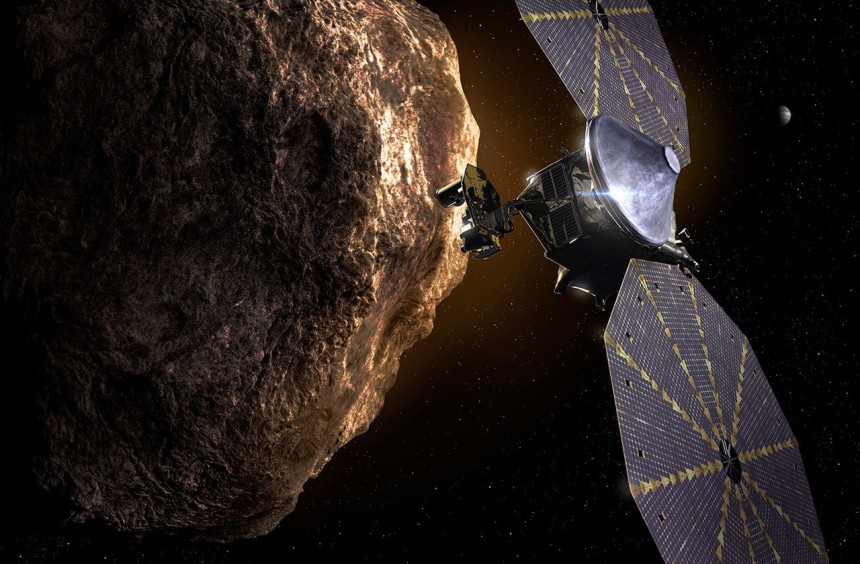Have you ever wondered how our solar system, its planets, and everything around us came to be? While scientists have a few theories that explain the origins of our cosmic home, none of them can be described as completely satisfactory. Now, for the first time, a space probe might be able to find the answers everyone is looking for.
NASA's Lucy spacecraft is on a 12-year mission to explore seven ancient asteroids, which might hold crucial clues about the origins of our solar system. The space probe was named after a fossilized skeleton of a pre-human ancestor discovered in Ethiopia in the '70s. Over time, the fossil proved to be extremely valuable, offering unique insights into human evolution. To honor its name, NASA's Lucy spacecraft promises to shed some light on how our planet and everything around it was formed by investigating the" fossils" of our solar system.
The ancient celestial objects have witnessed first-hand the history of the outer solar system. Called the Trojan asteroids, they are clumps of rock grains and ices that didn't make it into planets when everything was starting to take shape, roughly 4 billion years ago. They're some of the best-preserved materials from that time period and hold crucial evidence that might explain why the solar is the way it is today.
Lucy started its life as a mission to just two asteroids seven years ago. In 2014, Lucy was submitted as part of a call for proposals for the 13th mission for NASA's Discovery Program and, in 2017, Lucy was selected for development and launch.
From there, the space probe's journey was extended to include not two but seven celestial objects trapped within the gravity wells created by Jupiter and the Sun's combined pull. To properly investigate them, Lucy is equipped with various scientific instruments that will gather important data.
With the Lucy Thermal Emissions Spectrometer (L'TES), the spacecraft will investigate the Trojan surfaces' thermal environment. This will help scientists get a deeper understanding of the asteroid's physical characteristics.
Using an infrared imaging spectrometer, the probe will also look for ice and organics and determine the mineral composition of the Trojans. Its Long Range Reconnaissance Imager (L'LORRI) will provide detailed images of the geological features, aiding in determining the Trojans' age.
All of these instruments are located on the spacecraft's body. Attached to Lucy are huge solar panels. Each solar panel measures close to 24 feet (over 7 meters) in diameter, and they provide the power needed for the probe's systems as it flies out to the orbit of Jupiter.
Lucy has already started its four-billion-mile journey to the "fossils" of the solar system. The spacecraft launched on October 16th atop a United Launch Alliance Atlas V rocket from Cape Canaveral Space Force Station. Lucy is currently traveling at a speed of around 67,000 mph (108,000 kph) on a trajectory that will take it around the Sun and back to Earth for a gravity assist.
"It will still be several years before we get to the first Trojan asteroid, but these objects are worth the wait and all the effort because of their immense scientific value. They are like diamonds in the sky," said Hal Levison, Lucy's principal investigator.
Next year, the probe will use our planet's gravity to propel itself toward the Trojans. Once there, it will study the asteroids from about 620 miles (1,000 kilometers) away on average. In 2025, Lucy will fly past the first object from the asteroid belt, an asteroid named Donaldjohanson. This encounter will be used to test the spacecraft's instruments.
Lucy will approach its first swarm of Trojans 2027 in a gravitationally stable region known as a Lagrange point (precisely L4). The probe will have a close-up encounter with Eurybates and its satellite Queta and will fly by Polymele.
It will spend several months studying the two Trojans, and then, in 2028, Lucy will explore Leucus and Orus.
The spacecraft will then return to Earth for a third gravity assist that will propel it into the other group of asteroids located on Jupiter's opposite side. Finally, in the year 2033, it will meet up with Patroclus and Menoetius.
The ancient celestial objects have witnessed first-hand the history of the outer solar system. Called the Trojan asteroids, they are clumps of rock grains and ices that didn't make it into planets when everything was starting to take shape, roughly 4 billion years ago. They're some of the best-preserved materials from that time period and hold crucial evidence that might explain why the solar is the way it is today.
Lucy started its life as a mission to just two asteroids seven years ago. In 2014, Lucy was submitted as part of a call for proposals for the 13th mission for NASA's Discovery Program and, in 2017, Lucy was selected for development and launch.
From there, the space probe's journey was extended to include not two but seven celestial objects trapped within the gravity wells created by Jupiter and the Sun's combined pull. To properly investigate them, Lucy is equipped with various scientific instruments that will gather important data.
Using an infrared imaging spectrometer, the probe will also look for ice and organics and determine the mineral composition of the Trojans. Its Long Range Reconnaissance Imager (L'LORRI) will provide detailed images of the geological features, aiding in determining the Trojans' age.
All of these instruments are located on the spacecraft's body. Attached to Lucy are huge solar panels. Each solar panel measures close to 24 feet (over 7 meters) in diameter, and they provide the power needed for the probe's systems as it flies out to the orbit of Jupiter.
"It will still be several years before we get to the first Trojan asteroid, but these objects are worth the wait and all the effort because of their immense scientific value. They are like diamonds in the sky," said Hal Levison, Lucy's principal investigator.
Next year, the probe will use our planet's gravity to propel itself toward the Trojans. Once there, it will study the asteroids from about 620 miles (1,000 kilometers) away on average. In 2025, Lucy will fly past the first object from the asteroid belt, an asteroid named Donaldjohanson. This encounter will be used to test the spacecraft's instruments.
Lucy will approach its first swarm of Trojans 2027 in a gravitationally stable region known as a Lagrange point (precisely L4). The probe will have a close-up encounter with Eurybates and its satellite Queta and will fly by Polymele.
It will spend several months studying the two Trojans, and then, in 2028, Lucy will explore Leucus and Orus.
The spacecraft will then return to Earth for a third gravity assist that will propel it into the other group of asteroids located on Jupiter's opposite side. Finally, in the year 2033, it will meet up with Patroclus and Menoetius.
